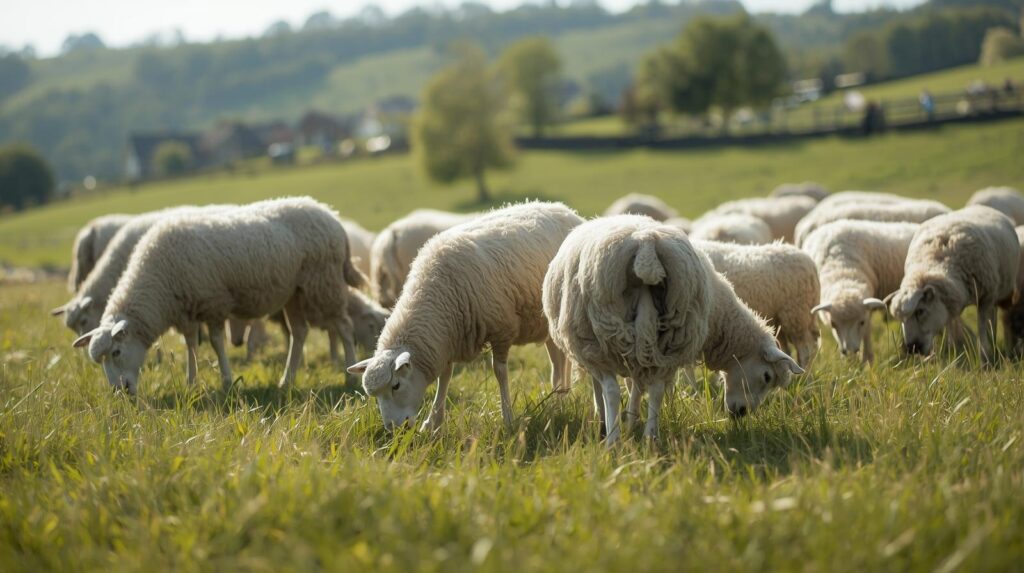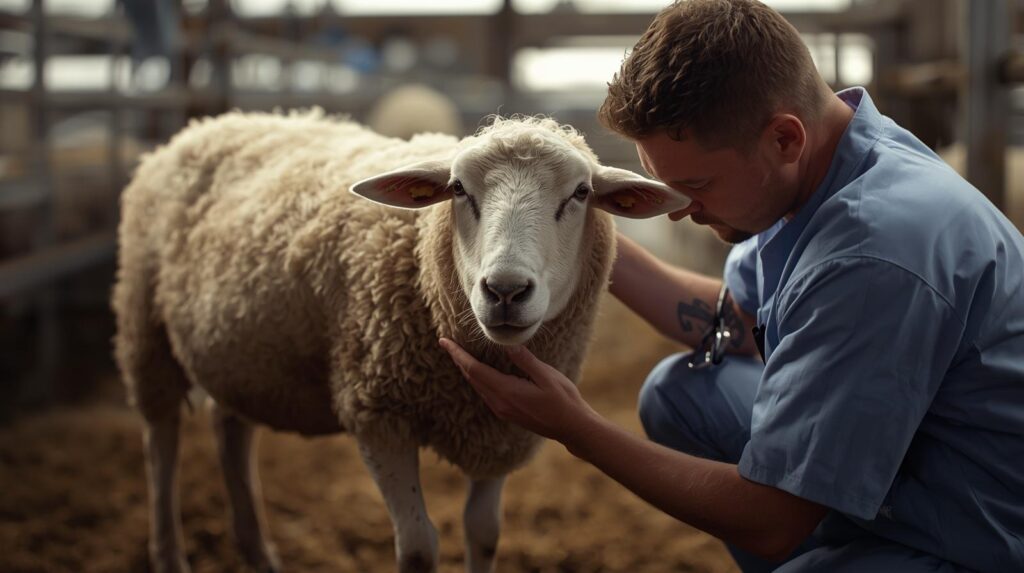Hey, have you ever watched your sheep acting a bit off and wondered what’s up? I’ve got a friend who runs a small flock, and he swears catching health problems early is the secret to keeping them happy and productive. Sheep are tough little creatures, but they hide sickness like pros, so spotting issues fast can save you a ton of hassle. Let’s talk about how to catch sheep health problems early, why it matters, and some practical tips to make it easier.
Sheep health issues can hit hard—think lost wool, lower meat quality, or even losing a lamb. Catching problems early can cut losses by 20–30%, according to farm studies. I’ve seen my friend’s flock bounce back from a rough patch just by paying closer attention. Here’s how you can do it too.
Why Early Detection Is a Big Deal
Sheep don’t exactly tell you when they’re feeling rough. They’ll keep grazing through pain until it’s serious. Early detection means less suffering, lower vet bills, and healthier lambs or wool. For example, catching a respiratory bug early might cost $10 in meds versus $100 if it spreads to the whole flock.
My friend missed a case of footrot once, and half his sheep were limping before he noticed. That was a pricey lesson. Spotting trouble early keeps your flock thriving and your wallet happy.
Common Sheep Health Issues to Watch For
Sheep face a few big health threats: footrot, parasites, respiratory diseases, and metabolic issues like pregnancy toxemia. Footrot shows up as limping or smelly hooves. Parasites cause weight loss or scruffy wool. Respiratory issues bring coughing or snotty noses. Pregnancy toxemia hits ewes late in pregnancy, making them weak or wobbly.
I saw a ewe with a cough that turned out to be pneumonia—caught it early, and she was fine after antibiotics. Tip: Learn these signs like the back of your hand. It’s like knowing when your kid’s got a fever before it’s a full-blown flu.

Watch Their Behavior Like a Hawk
Sheep tell you they’re sick through subtle changes. A healthy sheep is alert, eats eagerly, and sticks with the flock. If one’s lagging, not eating, or standing alone, something’s wrong. My friend noticed a ewe avoiding the feed trough—turned out she had a tooth abscess.
Check your flock daily, especially at feeding time. Look for dull eyes, droopy ears, or weird postures. Pro tip: Walk the same path each time so you notice who’s out of place. It’s like playing “spot the difference” with your sheep.
Physical Checks: Get Hands-On
Don’t just look—touch. Feel for lumps, check hooves for swelling, or run your hands over their wool for scabs. Body condition scoring (feeling the spine and ribs) tells you if they’re losing weight. A score of 2–3 out of 5 is ideal for most breeds.
My buddy found a lump on a ram’s neck during a check—early mastitis, fixed with a quick vet call. Do this weekly; it takes 10 minutes for a small flock. Warning: Don’t skip lame sheep—footrot spreads like wildfire if ignored.
Parasites: The Silent Thief
Internal parasites, like worms, are a huge issue. They cause anemia, weight loss, or “bottle jaw” (swelling under the chin). External ones, like mites, make sheep itch and lose wool. Studies say parasites can cut lamb growth by 15%.
Use a FAMACHA card ($10 online) to check eye color for anemia—pale means worms. My friend dewormed only the sick-looking sheep after checking, saving on meds. Tip: Rotate pastures and test manure yearly to catch parasite loads early.
Respiratory Problems: Don’t Ignore a Cough
Respiratory diseases, like pneumonia, hit fast, especially in damp or crowded barns. Look for coughing, nasal discharge, or heavy breathing. A sheep breathing hard after light exercise is a red flag.
I helped a neighbor catch a pneumonia case when his lamb sounded like it had a cold. A $20 telehealth call got antibiotics prescribed fast. Keep barns ventilated and avoid overcrowding. FAQ: Can it spread? Yep, so isolate sick sheep ASAP.
Metabolic Issues: Watch Pregnant Ewes
Pregnancy toxemia and hypocalcemia (milk fever) are scary for pregnant or lactating ewes. Toxemia shows as weakness or not eating, often in late pregnancy. Milk fever causes trembling or collapse post-lambing due to low calcium.
My friend lost a ewe to toxemia before he started checking ewes daily in late pregnancy. Feed high-energy grain to late-term ewes and keep calcium supplements handy ($15 a bag). Real-life win: Early grain feeding saved his next batch of lambs.
Using Tech for Early Detection:Sheep Health Issues
Tech’s making this easier. Wearable sensors, like those from HerdDogg, track heart rate or movement for $50 per tag. If a sheep’s less active, you get an alert. Apps like Farm4Trade let you log symptoms and share with vets remotely.
My buddy uses a cheap app to track his flock’s weight trends—caught a parasite issue before it got bad. Telehealth is huge too; a $25 video call can diagnose lameness or coughs. Warning: Tech’s a tool, not a replacement for daily checks.
Telehealth: Your Vet in Your Pocket
Speaking of telehealth, it’s a game-changer for sheep farmers. Apps like Vetster connect you to vets who can check videos of limping or coughing sheep. It’s cheaper than a farm visit—$30 versus $100—and fast.
I know a farmer who used telehealth to confirm footrot; the vet guided treatment over chat, and the flock was back to normal in a week. It’s great for small farms or remote areas. FAQ: Can it replace vets? Not for surgeries, but awesome for early checks.
Prevention: Stop Problems Before They Start
Prevention beats cure. Vaccinate for common diseases like clostridial infections ($1 per dose). Keep pastures clean to cut parasites. Trim hooves every 6–8 weeks to prevent footrot—takes 5 minutes per sheep.
My friend started a strict deworming schedule, and his lamb losses dropped 10%. Feed balanced diets with minerals; a $20 mineral block lasts a month. Benefit: Healthy sheep mean more wool, meat, or lambs—and less stress.

Common Mistakes to Avoid
It’s easy to slip up. Ignoring a limp can let footrot spread. Skipping vaccinations risks outbreaks. Overfeeding grain can cause acidosis—think upset stomachs for sheep. My buddy once fed too much grain, and his ewes bloated; he learned to measure carefully.
Check feed quality—moldy hay can cause respiratory issues. And don’t assume “they’ll be fine.” If a sheep’s off, act fast. A $50 vet call is cheaper than losing a $200 ewe.
Practical Tips for Your Flock
Start easy: Walk your flock daily, looking for loners or limpers. Learn FAMACHA scoring—takes an hour to practice. Keep a first-aid kit with dewormers, antibiotics, and hoof trimmers ($50 total). My friend keeps a notebook for each sheep’s quirks—super helpful.
Invest in a $10 thermometer; fever (over 103°F) means trouble. Use telehealth for quick vet advice. And talk to your sheep—they’ll “show” you issues if you watch closely. Benefit: Early catches save 20% on costs and keep your flock strong.
FAQs: Quick Answers for Farmers
How do I know if it’s serious? Lameness, not eating, or breathing hard means call a vet fast.
Can I treat parasites myself? Yes, with dewormers, but use FAMACHA or vet advice to avoid overuse.
What’s the best way to check hooves? Lift each foot weekly; look for swelling or bad smells.
Do lambs get sick easier? Yep, they’re fragile—watch for diarrhea or weakness.
Is telehealth worth it? For quick checks or remote farms, it’s a lifesaver.
Got more questions? Telehealth apps or local co-ops have free advice chats.
Wrapping It Up: Keep Your Sheep Thriving
Catching sheep health issues early is like catching a leak before it floods your house. Watch behavior, check bodies, and use tools like telehealth or sensors to stay ahead. It’s saved my friend’s flock from major losses, and it can help yours too.
Try one thing today—maybe a quick hoof check or a telehealth app download. Your sheep will reward you with better wool, healthier lambs, and fewer headaches. What’s your first step to healthier sheep?
